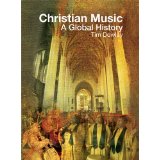~by Michael W. Campbell~
Tim Dowley, Christian Music: A Global History. Minneapolis, MN: Fortress Press, 2011. 256 pp. + 7 pp. Index. $35.00.
Music has always been a divisive issue in Christian history. As a pastor that at least makes me feel better when “worship wars” break out in the local church. Dowley’s magisterial overview builds upon Harry Eskew’s Sing With Understanding: An Introduction to Christian Hymnology (Genevox, 1995) a now dated work, as well as a recent surge of publications on American hymnody (e.g. Mark A. Noll and Richard J. Mouw’s Wonderful Words of Life: Hymns in American Protestant History and Theology [Eeddmans, 2004]). I am personally very much impressed with Dowley’s research; I currently use his text Introduction to the History of Christianity (Fortress, 2002) in my survey class in Church History that I teach for Friends University.
What I like most is that this book is very approachable for a person like me who has only a cursory background in music. Although the book can get quite technical at points in describing the development of music, Dowley does a fine job of bringing his reader along with him by explaining what the terms mean. I especially appreciated all the illustrations! For that reason alone the book is well worth the price. And not to be overlooked is the list of the author’s favorite recordings.
The book is neatly organized into 21 chapters. The author highlights Biblical music (chapter 1), the early church (chapter 2), music after Constantine (chapter 3), medieval worship (chapter 4), and the discover of harmony (chapter 5) and polyphony (chapter 6). Dowley then delves into specific traditions: Lutheran Reformation (chapter 7), Anglican (chapter 8), and Catholic Baroque (chapter 10). This is interspersed with a chapter on the Genesis of Christian hymns (chapter 9) and music in Vienna (chapter 12), most notably the composers Haydn, Mozart, and Beethoven. Dowley is perhaps at his best in a biographical chapter shared between Bach and Handel—my favorite chapter of the book (chapter 11). Then he returns for a look at music as related to Romanticism (chapter 13), 19th-century hymns (chapter 14), revivalism (chapter 15), Negro Spirituals (chapter 16), the 20th-century (chapters 17-19), development of the contemporary Christian music industry (chapter 20) and the rise of Christians doing Country, Folk, and Jazz (chapter 21). The author is comprehensive and fair in his treatment of this wide array of tastes and styles.
What surprised me most was how controversial the organ was!
The organ was frequently proscribed by popes and church edicts but was increasingly used for worship through the Middle Ages. “One effect,” writes Dowley, “of the Protestant Reformation and Roman Catholic response to it was to bring words to the fore in worship. They were to be readily heard and understood, and the organ’s role changed to that of supporting the singing” (83). I also appreciated learning more about just how much some of my favorite hymns have changed through the years: especially “Amazing Grace” replete with corrupted versions in a time when as many as 10 different tunes were used by the late 19th-century. The hymn had not only religious significance but became associated with the Civil Rights struggle during the 1960s and even outside the church when it was sung at the opening of the Woodstock Festival in 1969. The stories of these songs—both ancient and modern—help us better understand just how important music is to our faith.
I heartily recommend this book to my pastoral colleagues who want to enrich their own personal understanding of worship. I believe such an understanding will add depth to your ministry and provide rich insights into the songs that are sung each week in your own congregation. And if you happen to be in the midst of a “worship war” perhaps you can encourage your worship leaders to pause to ponder how others have grappled with the same issues because in all probability someone has wrestled with the same issue before.
Michael W. Campbell is lead pastor of the Wichita South Seventh-day Adventist Church in Wichita, Kansas.











